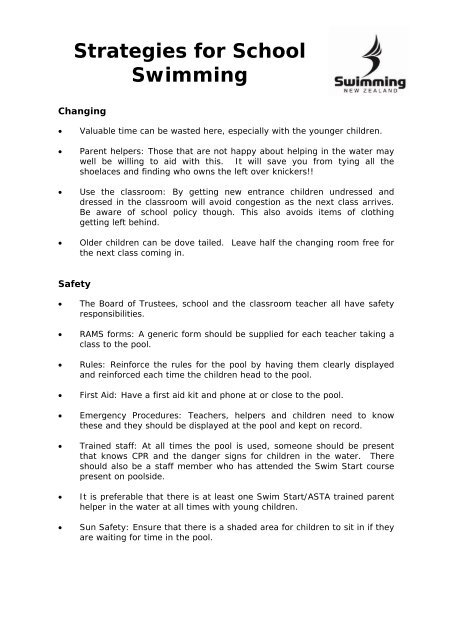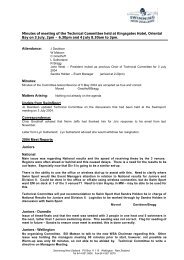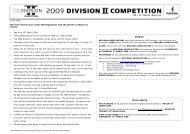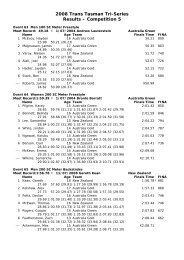Strategies for School Swimming - Swimming New Zealand
Strategies for School Swimming - Swimming New Zealand
Strategies for School Swimming - Swimming New Zealand
You also want an ePaper? Increase the reach of your titles
YUMPU automatically turns print PDFs into web optimized ePapers that Google loves.
<strong>Strategies</strong> <strong>for</strong> <strong>School</strong><br />
<strong>Swimming</strong><br />
Changing<br />
• Valuable time can be wasted here, especially with the younger children.<br />
• Parent helpers: Those that are not happy about helping in the water may<br />
well be willing to aid with this. It will save you from tying all the<br />
shoelaces and finding who owns the left over knickers!!<br />
• Use the classroom: By getting new entrance children undressed and<br />
dressed in the classroom will avoid congestion as the next class arrives.<br />
Be aware of school policy though. This also avoids items of clothing<br />
getting left behind.<br />
• Older children can be dove tailed. Leave half the changing room free <strong>for</strong><br />
the next class coming in.<br />
Safety<br />
• The Board of Trustees, school and the classroom teacher all have safety<br />
responsibilities.<br />
• RAMS <strong>for</strong>ms: A generic <strong>for</strong>m should be supplied <strong>for</strong> each teacher taking a<br />
class to the pool.<br />
• Rules: Rein<strong>for</strong>ce the rules <strong>for</strong> the pool by having them clearly displayed<br />
and rein<strong>for</strong>ced each time the children head to the pool.<br />
• First Aid: Have a first aid kit and phone at or close to the pool.<br />
• Emergency Procedures: Teachers, helpers and children need to know<br />
these and they should be displayed at the pool and kept on record.<br />
• Trained staff: At all times the pool is used, someone should be present<br />
that knows CPR and the danger signs <strong>for</strong> children in the water. There<br />
should also be a staff member who has attended the Swim Start course<br />
present on poolside.<br />
• It is preferable that there is at least one Swim Start/ASTA trained parent<br />
helper in the water at all times with young children.<br />
• Sun Safety: Ensure that there is a shaded area <strong>for</strong> children to sit in if they<br />
are waiting <strong>for</strong> time in the pool.
<strong>Strategies</strong> <strong>for</strong> <strong>School</strong><br />
<strong>Swimming</strong><br />
Non-Swimmers<br />
• Make sure that the non-swimmers are kept busy. Perhaps a general<br />
fitness circuit or some written aquatic research could be used. Water<br />
safety puzzles/activities/stories etc are also a good idea.<br />
Grouping<br />
• Ability Group: By having several small groups working at different times<br />
you will achieve greater success. You can do more <strong>for</strong> a child in a small<br />
group in 8 - 10 minutes than <strong>for</strong> 30mins with the whole class.<br />
• Parent Helpers: Enlist the help of as many people as possible e.g.,<br />
parents, teacher aids. It is preferable if you can encourage these parent<br />
helpers to attend a Swim Start/ASTA course. For young children e.g.<br />
Year O – 3 this is strongly recommended.<br />
• Movement of groups: Don’t be afraid to rotate the groups in the water.<br />
Pair up with another teacher or syndicate or have laminated activity cards<br />
on the pool side <strong>for</strong> children to work from.<br />
Maximize Pool Use<br />
• The time which you have in the pool is limited. Maximise it by being well<br />
planned and have 2 groups going at once if you have a qualified parent<br />
helper.<br />
• Don’t be afraid to have a warm up or highlight the main teaching points<br />
outside of the pool. This can be done in the classroom be<strong>for</strong>e the pool<br />
session so valuable in water time will not be lost on this.<br />
• Ensure that there is a pool use timetable to avoid confusion and double<br />
ups.<br />
• Think about how the lessons are scheduled – often intensive swim<br />
week(s) are better than once a week <strong>for</strong> a term.<br />
• Laminated, progressive lesson plans are available through <strong>Swimming</strong> <strong>New</strong><br />
<strong>Zealand</strong> at a very af<strong>for</strong>dable price, so use these to start off with and know<br />
that you are covering what needs to covered. These would be invaluable<br />
<strong>for</strong> a parent helper also.
<strong>Strategies</strong> <strong>for</strong> <strong>School</strong><br />
<strong>Swimming</strong><br />
Incentives<br />
• Just as in the classroom the children respond to rewards. Certificates,<br />
wall charts, stickers can all be used to encourage students. These are all<br />
available through <strong>Swimming</strong> <strong>New</strong> <strong>Zealand</strong>, so all the work is done <strong>for</strong> you.<br />
• Make sure that the progressions are small and achievable so that even<br />
the most hesitant swimmer has something to work towards.<br />
Routines<br />
• Behaviour in the pool is just as important, if not more so, than in the<br />
classroom. We all know that children play up when they are in an<br />
exciting & different environment so remember to have pre established<br />
rules in place.<br />
• Have a whistle and ensure that all children know what one, two or three<br />
beeps on the whistle mean.<br />
• Don’t be afraid to get pupils out of the pool if they push the boundaries.<br />
Missing one lesson will not have a great effect on their overall progress.<br />
Evaluation<br />
• Keep records of each pupil’s progress so that you and/or the next teacher<br />
can easily and appropriately group them. The Swim Start evaluation sheet<br />
is all done <strong>for</strong> you and this matches up with the achievement certificates.<br />
This means that you do not need to reinvent the wheel.<br />
• Ensure that these records are passed on to the next teacher at the start<br />
of the year.<br />
Other Options<br />
• Dry-land practices: This provides get opportunities to physically correct<br />
stroke techniques.<br />
• Watch a video: <strong>Swimming</strong> can be hard to explain. If you are not sure<br />
that you can demonstrate correctly, use a video of someone who can.<br />
• Buddies: Use the older, more capable swimmers to help with the junior<br />
syndicate. It will be great <strong>for</strong> their leadership and communication skills.<br />
Check with the local High <strong>School</strong>’s PE students to see if they are<br />
completing Swim Start as part of their Year 12 programme. They may be<br />
looking <strong>for</strong> some teaching experience.
<strong>Strategies</strong> <strong>for</strong> <strong>School</strong><br />
<strong>Swimming</strong><br />
• The local swimming club: These are the experts in your area and are<br />
always keen to identify new talent. Ask if they can help with an extension<br />
group at lunchtime or running the school swimming sports.<br />
• Swim Start/ASTA fits into the Health and Physical Education Curriculum in<br />
such a way that there are many opportunities <strong>for</strong> written projects e.g. on<br />
safety/ survival skills.<br />
Equipment<br />
• Don’t be afraid to improvise with the PE equipment. Use balls, hoops,<br />
lifejackets, flutter boards, buckets, 2 L milk bottles, gumboots or anything<br />
that floats. These can all be used as floatation and teaching aids.<br />
• Equipment can be cheap e.g. 2 litre plastic milk bottles make great<br />
floatation aids.<br />
Planning<br />
• Use a recognised programme such as Swim Start. Why do all the<br />
planning when someone has done it <strong>for</strong> you? Remember to be clear<br />
about what you are targeting that day at the pool and remember the key<br />
teaching points.<br />
• Routines and organisation are just as important to plan as lesson content.<br />
• Aim to teach the basics well e.g. Water confidence, Floating.<br />
Streamlining, Kicking and Arm strokes. Don’t feel that you need a huge<br />
technical knowledge of swimming to do a good job.<br />
• Disguise as many skills as possible as games. This ensures a fun, non<br />
threatening learning environment.<br />
For more in<strong>for</strong>mation please contact:<br />
Arjun Haszard<br />
Regional Education Manager<br />
<strong>Swimming</strong> <strong>New</strong> <strong>Zealand</strong><br />
03 387 0372<br />
027 291 6107<br />
arjun@swimmingnz.org.nz
















